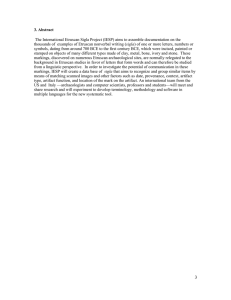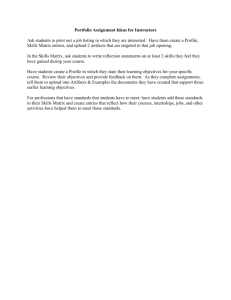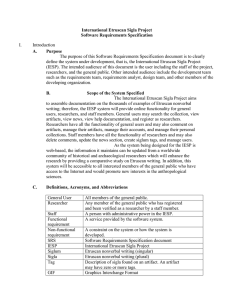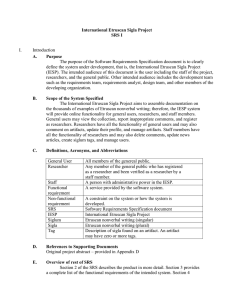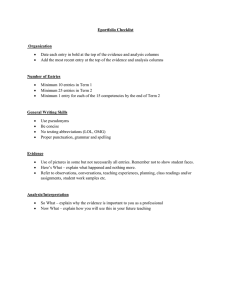Video Rental System SRS I and II A. Purpose
advertisement
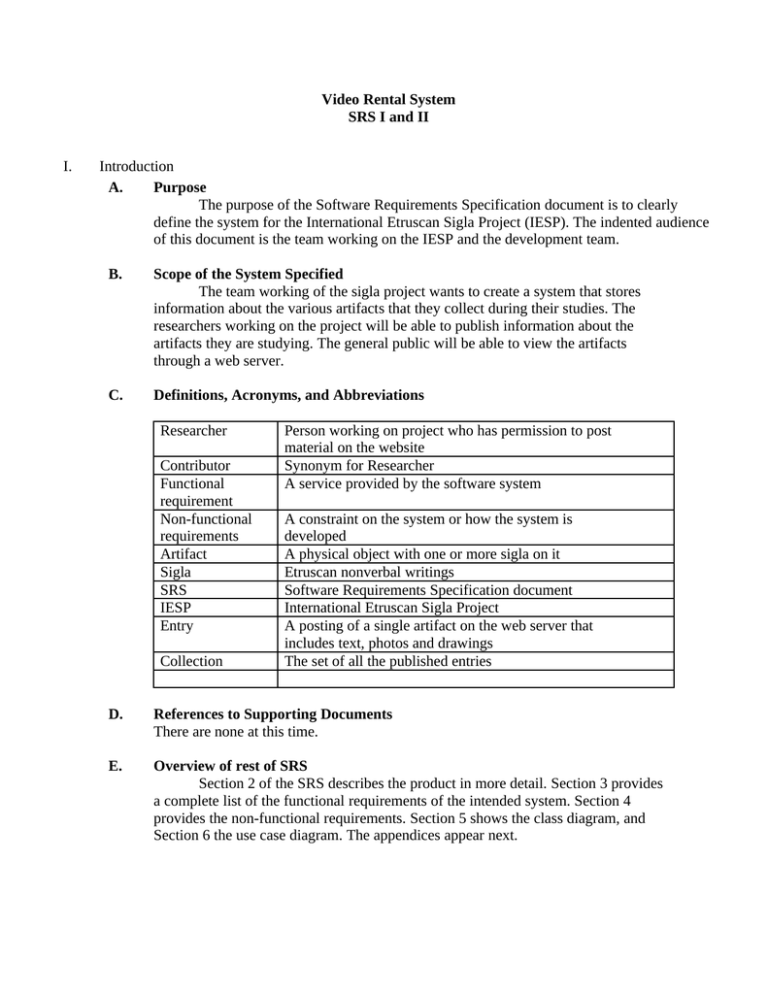
Video Rental System SRS I and II I. Introduction A. Purpose The purpose of the Software Requirements Specification document is to clearly define the system for the International Etruscan Sigla Project (IESP). The indented audience of this document is the team working on the IESP and the development team. B. Scope of the System Specified The team working of the sigla project wants to create a system that stores information about the various artifacts that they collect during their studies. The researchers working on the project will be able to publish information about the artifacts they are studying. The general public will be able to view the artifacts through a web server. C. Definitions, Acronyms, and Abbreviations Researcher Contributor Functional requirement Non-functional requirements Artifact Sigla SRS IESP Entry Collection Person working on project who has permission to post material on the website Synonym for Researcher A service provided by the software system A constraint on the system or how the system is developed A physical object with one or more sigla on it Etruscan nonverbal writings Software Requirements Specification document International Etruscan Sigla Project A posting of a single artifact on the web server that includes text, photos and drawings The set of all the published entries D. References to Supporting Documents There are none at this time. E. Overview of rest of SRS Section 2 of the SRS describes the product in more detail. Section 3 provides a complete list of the functional requirements of the intended system. Section 4 provides the non-functional requirements. Section 5 shows the class diagram, and Section 6 the use case diagram. The appendices appear next. II. General Description 2. Product Perspective The system is web-based, providing functionality to users through a web browser. It interfaces with a database that stores all of the relevant information regarding the authorized personnel, and the Etruscan artifacts. The system provides a secure environment for authorized personnel to submit information and manage data about Etruscan artifacts so that associations may be analyzed and better understood. 3. Product Functions The system allows public users to search entries by means of keywords, browsing trees, and by choosing from a list of similar entries. They may also view entries on the site and retrieve a citation of the corresponding artifact entry. Authorized personnel have the ability to log into the system and manipulate the data. They’re split into two categories, contributors and system administrators. A contributor has the ability to manipulate data by creating entries, creating collections of entries and modifying collections as well as unpublished entries. They also have the ability to add additional information to each entry. A contributor may choose to make data official and publish an entry to be displayed. Once published, they may no longer modify an entry. Each contributor also has the same abilities as public users. A system administrator is allowed to manage contributor accounts as well as modify published entries. Because a contributor must be verified before their account is activated, this is an important task to the system. Also, they are the only one who may modify any data once it’s been published so that the system remains stable and accurate. System Administrators have the additional permissions of both contributors as well as public users. 4. User Characteristics Interaction with the system is carried out by the three groups of public users, contributors and system administrators. A public user is anyone who is accessing the system without the need for any special permissions. They are limited in functionality, but require nothing more than the knowledge of how to use a web browser. A contributor is someone who has been authorized to log into the site and modify data. They must be familiar with the format of the system as well as the relevant data for an artifact entry. This may require minimal training in order to familiarize oneself with the system. A contributor has the ability to organize entries in the form of a collection to provide more ease of use. A system administrator is someone who has authorization to log into the site, as well as modify publish and unpublished entries. It is the responsibility of a system administrator to verify and manage contributor accounts. They must be very familiar with the system and understand the requirements of entries and contributors. They have the highest permissions in the system and may modify data that has been published and is important to keep consistent. 5. General Constraints The system provides web access for all users. The user interface should be intuitive enough so that there is no training required to search and view entries or generate citations. Contributors and system administrators must also be able to easily understand the system and how to create and modify data appropriately. All data of authorized personnel as well as artifact information will be stored securely. Persistent information on all artifacts and authorized personnel will be maintained. 6. Assumptions and Dependencies There are no assumptions or dependencies at this time.
